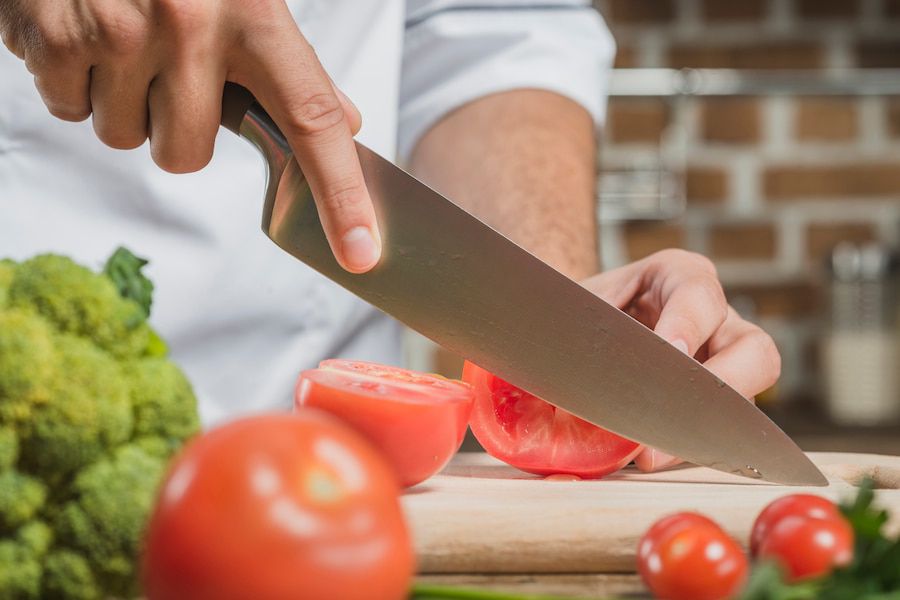Creating a hammered finish on a chef knife has become a widely appreciated skill among kitchen enthusiasts, knife makers, and professionals. This method not only enhances the knife’s visual appeal but also introduces functionality by reducing food sticking to the blade. Today, well guide you step-by-step on how to do the hammered finish on a chef knife, helping you create a timeless kitchen tool with personality and functionality. By following this guide, any individual with a passion for craftsmanship can create a terrific hammered finish! Lets dive in.

1. What Is the Hammered Finish?
A hammered finish, also known as a ‘tsuchime’ finish, is a traditional Japanese method to texture chef knives. Small indentations are hammered into the blade, offering a highly aesthetic, distinctive look and reducing food adhesion while cutting.
2. Why Choose a Hammered Finish on a Chef Knife?
- It minimizes food sticking to the blade during cutting.
- Adds a tremendous visual appeal to the chef knife.
- Improves the knife’s uniqueness and authenticity.
- Creates a textured grip for hands during use.
3. Tools and Materials You’ll Need
Before embarking on how to do the hammered finish on a chef knife, gather the necessary materials:
- A chef knife or blank blade
- A hammer (preferably with a ball-peen end)
- Secure surface or anvil
- Safety goggles and gloves
- Polishing ball or soft buffing wheel
- Optional: Protective coatings for preservation
4. Preparation: Planning Your Hammered Design
Preparation is key to crafting a terrific hammered finish. Here are the steps:
- Clean the surface of the blade to remove residues.
- Map out the hammered pattern using chalk or marker to ensure uniform density.
5. Step-By-Step Process to Create the Hammered Finish
Step 1: Set Up Your Workspace
Ensure your workplace is safe and stable. Use a robust, flat surface or an anvil to position the blade securely.
Step 2: Mark and Secure the Blade
Secure the blank chef knife using clamps. Mark desired hammering points for precise and consistent results.
Step 3: Begin Hammering
Using a ball-peen hammer, gently but firmly tap onto the marked points. Vary the depth and shape of marks for authenticity.
Step 4: Refine Your Hammered Texture
Use a polishing ball or buffing machine to smoothen edges while retaining the hammered look.
Step 5: Clean and Polish
Finally, clean the blade thoroughly and apply a protective coating to enhance durability.
6. Safety Is Key
Working with sharp blades and heavy-duty tools can be dangerous. Always wear safety goggles, gloves, and closed-toe shoes when crafting your hammered finish to prioritize safety during each stage of the process.
7. Adding the Hammered Finish to Knife Sets
Did you know that incorporating a hammered finish to your knives can make them more desirable when crafting knife sets for sale? It adds a unique selling point and helps differentiate your knives in the market!
8. Maintaining Your Hammered-Finish Knife
Once you finish your masterpiece, maintaining it is essential. Use warm water and mild soaps to clean the blade. Avoid abrasive sponges that could scratch the surface or harm the hammered areas.
Check out this excellent article for more cleaning tips on cutting techniques to preserve your kitchen tools!
9. Common Mistakes to Avoid
When it comes to achieving a hammered finish, remember:
- Do not overstrike, as deeper dents can weaken the blade.
- Do not rush; uneven patterns may reduce visual appeal.
10. Consult or Collaborate with Knife Experts
If making knives is new for you, consider reaching out to seasoned knife makers. Collaborative learning enhances your craftsmanship.
11. Learning Advanced Techniques
If youre keen to further venture into knife crafting, explore advanced guides on topics like cutting turkey or glass cutting using knives.
FAQs
1. Can I Perform This Technique on a Commercial Knife?
Yes, but ensure the blade metal is suitable for hammering and can withstand the impact without compromising durability.
2. Does the Hammered Finish Affect the Knife’s Cutting Efficiency?
No, in fact, it improves efficiency by reducing the chances of food sticking to the blade. However, it must be done correctly.
3. What Tools Can Substitute a Ball-Peen Hammer?
You can use a manual embossing tool or similar hammers as substitutes, but precision may vary.

Final Thoughts
Learning how to do the hammered finish on a chef knife is a skillful art that merges visual beauty and functionality. With the steps above, you can add significant value to your knives, making them special tools in your kitchen or as heirlooms to pass on.
Ready to kickstart your creative knife-making journey? Delighted to guide you!
This article contains affiliate links. We may earn a commission at no extra cost to you.


